|
Eureka County Revenues
Eureka County uses fund accounting to ensure and demonstrate compliance with finance-related legal requirements. The county funds are divided into three categories: governmental funds, proprietary funds, and fiduciary funds. Eureka County maintains thirty-one individual government funds, one proprietary fund (the Devil's Gate General Improvement District), and one fiduciary fund. The tables and graphs presented here show trends in Eureka County revenues, both by fund and by revenue source. (Note: Some smaller revenue sources do not appear in the bar graphs due to the scale of the graph.)
Ad valorem taxes and intergovernmental revenues continue to be the two main sources of Eureka County revenues, with ad valorem taxes accounting for 56.3 percent and intergovernmental revenues accounting for 36 percent of total 2017 revenues.
Eureka County has a policy of retaining large ending balances and building up reserve funds. Eureka County has three reserve funds, including a Future Reserve Fund and a Building Operation and Maintenance Reserve Fund. The 2014 Comprehensive Annual Report explains the purpose of these funds as follows: "The County will rely on its Future Reserve Fund to help cushion the impact of a mine closure”. A Building Maintenance Fund is in place to ensure proper maintenance of all County structures. The Regional Transportation Fund will hold reserve money for the specific purpose of constructing and maintaining county roads. These funds will give the citizens of the County a grace period to absorb the financial impact of such an event.
On June 30, 2017, the balance in the Future Reserve Fund was $10,675,890 and the balance in the Building Operation and Maintenance Reserve Fund was $5,355,913. The Road Fund had an ending fund balance of $7,018,681. The Comprehensive Annual Report reports further financial highlights for fiscal year 2017:
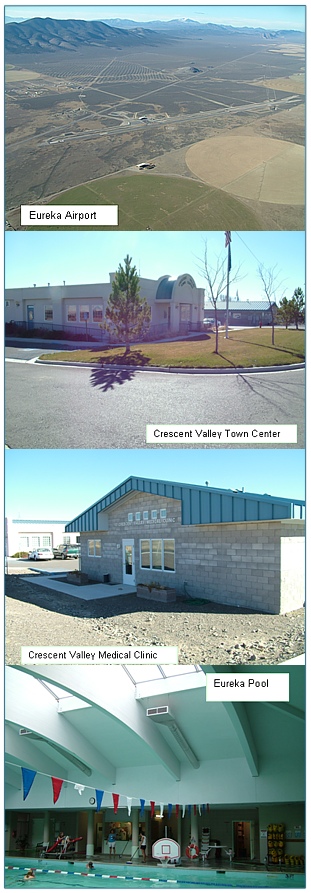
- The County expect an increase in sales tax revenues going forward. However, an increase in Net Proceeds of Mines is not expected.
- There were no new funds established and no funds were closed in 2017.
- The County as of June 30, 2017 had no bonded debt.
- General Fund cash and investments increased from $14,411,254 in 2016 to $18,629,647 in 2017.
- At June 30, 2017, the total fund balance for the general fund was $19,287,931
- Total County cash at June 30, 2017 was $62,692,463. Total cash and investments were $65,960,420.
- There were no major leadership changes for Eureka County during fiscal year 2017.
Eureka County's Fiscal Policies Protect County During Economic Slowdowns
As Figure 4-1 shows, Eureka County's fiscal policies have resulted in a steadily growing fund balance substantial reserve. Over the last several years major governmental fund types have been reduced to the general fund, future reserve fund, road fund, and the RTC fund.
Table 4-2 shows Eureka County revenues by source. Taxes and intergovernmental revenues are the primary sources of government funding. Both are highly influenced by economic conditions. Figure 4-2 shows the proportionality of general government revenue sources. Figure 4-3 graphs the growth in tax revenues by source over the last 24 years.
Eureka and Crescent Valley
The town of Eureka, the county seat, is in the southern portion of the county, and Crescent Valley is in the northern part of the county. Both towns are unincorporated. A 3-member Crescent Valley Advisory Board, under the authority of the Eureka County Board of County Commissioners, governs Crescent Valley.
The principal services provided by the town of Eureka are fire protection, streets and street lighting, water and sewer service, while Crescent Valley provides fire protection, streets, water, maintenance of a park, and some general government functions. The primary revenue source for Eureka Town is ad valorem tax followed by state gaming license fee. The town of Crescent Valley is supported ad valorem tax revenues.
Table 4-3 and Figure 4-4 shows Town of Eureka revenues by source. Table 4-4 and Figure 4-5 shows the Town of Crescent Valley revenues by source.
EUREKA COUNTY TAX RATES
The statutory maximum ad valorem tax rate is $3.64 per every $100 of valuation. Eureka County's total property tax rate in FY 2017-18 is 1.8743. This translates to a property tax impact of $656.88 on a home with a $100,000 taxable value (The assessed value, on which the ad valorem tax is levied, is set at 35 percent of the taxable value).
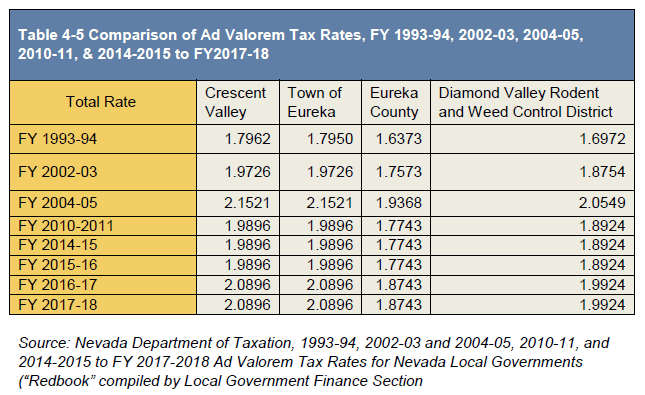 Actual combined tax rates vary according to area within Eureka County. The towns of Crescent Valley and Eureka levy $2.0896, while the Diamond Valley Rodent and Weed Control Districts levy $1.9924 (Table 4-5). The average overall property tax rate in the county is approximately the same as it was in FY 2002-03.
Actual combined tax rates vary according to area within Eureka County. The towns of Crescent Valley and Eureka levy $2.0896, while the Diamond Valley Rodent and Weed Control Districts levy $1.9924 (Table 4-5). The average overall property tax rate in the county is approximately the same as it was in FY 2002-03.
Eureka County maintains one of Nevada's lowest average countywide tax rates. Table 4-6 shows the tax rates and assessed value by taxing units. Table 4-7 shows a history of assessed values by taxing district. Assessed value has increased substantially since 1994.
Total Assessed Valuation Dips in 2017
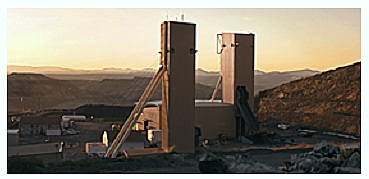 Since FY 1994-95, total assessed valuation in Eureka County, which consists of the area outside of incorporated towns and contains most of the county's tax base, has increased from $424.23 million in FY1994-95, to a peak of $2.054 billion in FY 2012-13, an increase of 384 percent. Increases in assessed value are largely attributed to mining operations in Eureka County (Figure 4-6).
Since FY 1994-95, total assessed valuation in Eureka County, which consists of the area outside of incorporated towns and contains most of the county's tax base, has increased from $424.23 million in FY1994-95, to a peak of $2.054 billion in FY 2012-13, an increase of 384 percent. Increases in assessed value are largely attributed to mining operations in Eureka County (Figure 4-6).
Recent declines in assessed value occurred in FY 2014-15 and continued through 2017-18. This drop in countywide assessed value was due primarily to the closure of the Ruby Hill mine, and a reduction in new construction and depreciation. While total assessed valuation of the towns of Eureka and Crescent Valley are minor compared with the rest of the county, total assessed valuations in the towns increased during the FY 1994-95 to FY 2017-18 period. Assessed valuation in Eureka Town rose from $3.9 million to just over $14.6 million during the period (Figure 4-7).
In Crescent Valley, total assessed valuation climbed from $1.45 million in 1994-95 to $4.62 million in 2017-2018. The trend in assessed value demonstrates continued modest increases overtime. Table 4-8 shows principal taxpayers in Eureka County. Again, mining dominates the list in Table 4-8.
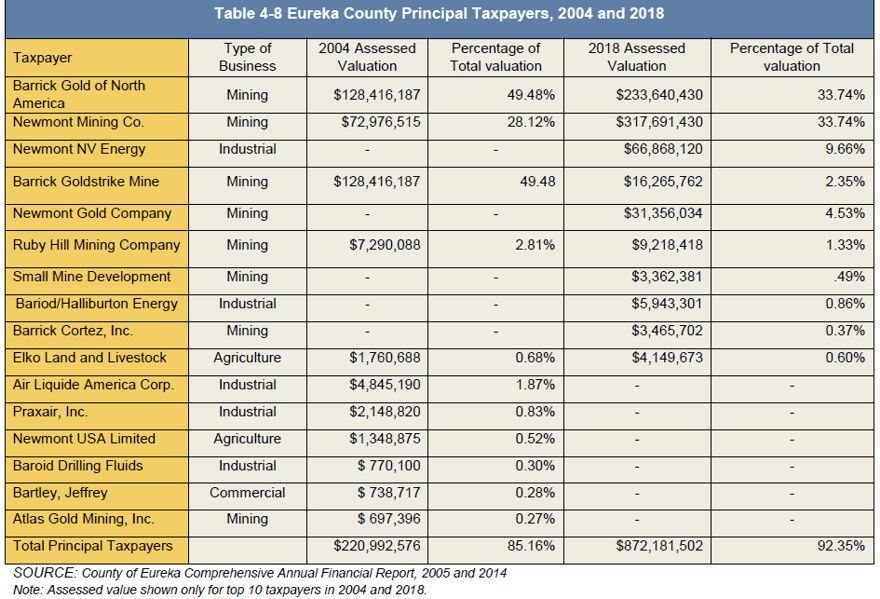
Eureka County Expenditures
In 2017 the county expended a total of $14,189,882, a significant reduction from peak expenditures of $35,668,602 in 2012 (Table 4-9). Expenditure levels were reduced because of a decline in revenues. The General Government and Public Safety functions within the County's General Fund, together with the Road Fund are the largest County expenditure categories. General Fund expenditures make up 71 percent of County expenditures. As shown in Figure 4-8, revenues have generally outpaced expenditures, although both fell significantly beginning in 2014.
The County reduced building and maintenance, RTC, and capital improvements funds over the last several years. No money was spent from the Future Reserve Fund in the last 14 years. Over the last 3 years, limited expenditures were made for building operations and maintenance, and regional transportation commission. Figure 4-9 shows county expenditures and the expenditure trend for the years 1999 - 2017.
Figure 4-10 shows General Fund expenditures from 1999 to 2017. Although government expenditures have increased in recent years, the total amount spent for general government functions such as public safety and administration has not experienced the same level of increases (Figure 4-11) suggesting that many of the expenditures are being made for non-recurring items such as capital improvements. During periods of economic slowdowns primarily in the mining sector when large swings in revenues occur, Eureka County reduces expenditures in non-recurring and capital spending accounts.
Eureka Town and Crescent Valley Expenditures
Public works and public safety are the principal functions of the town of Eureka. Government expenditures; other functions - culture and recreation, general government, capital improvements, health, are a part of County expenditures. Crescent Valley is far from the county seat, so some government functions that are performed by the County in Eureka town are performed in the town in Crescent Valley, and expenditures reflect this. Like other governmental functions in Eureka County, expenditures have increased for the Town of Eureka and Crescent Valley (Table 4-11). Figure 4-12 shows 2017 expenditures by category.
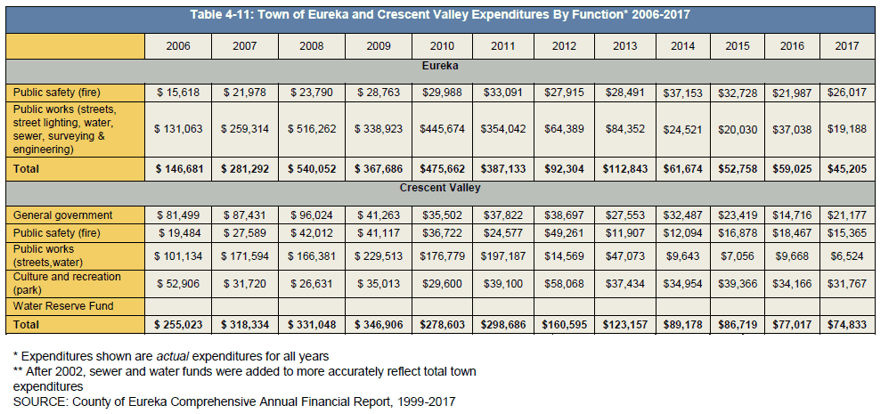
|


